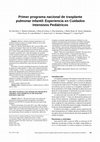Papers by Angel Salvatierra Velázquez

Anales De Pediatria, 1999
El trasplante pulmonar (TP) infantil se desarrolló tras los resultados con adultos . En principio... more El trasplante pulmonar (TP) infantil se desarrolló tras los resultados con adultos . En principio, se realizaron trasplantes combinados (corazón y pulmón) , pero la escasez de donantes, la recuperación cardíaca tras el TP aislado y la posibilidad de arteriosclerosis precoz coronaria en el trasplante combinado , dieron preferencia al TP aislado, limitando la indicación de trasplante de corazón-pulmón a la disfunción severa del corazón izquierdo con enfermedad vascular pulmonar . La indicación más frecuente del TP en pediatría es la fibrosis quística (FQ) . Otras son: hipertensión pulmonar primaria, fibrosis pulmonar, cardiopatías congénitas con enfermedad vascular pulmonar, bronquiolitis obliterante (BO), estenosis congénita de venas pulmonares, displasia broncopulmonar, síndrome de dificultad respiratoria aguda o hipoplasia pulmonar por hernia diafragmática congénita . El objetivo del trabajo es analizar nuestra experiencia durante el postoperatorio en Cuidados Intensivos Pediátricos (UCIP) tras quince meses de funcionamiento del primer programa de TP infantil en España.
La bronquiolitis obliterante (BO) es la complicacion mas importante y la principal causa de muert... more La bronquiolitis obliterante (BO) es la complicacion mas importante y la principal causa de muerte tras el trasplante de pulmon. Entre los modelos experimentales en animales, el mas empleado es el del trasplante heterotopico de traquea en roedores. Sin embargo, la patogenesis de la BO sigue aun pendiente de esclarecer.
Archivos de Bronconeumología, 2020
Transplantation Proceedings, 2020
Post-thoracotomy wound dehiscence after a lung transplant carries with it morbidity in the postop... more Post-thoracotomy wound dehiscence after a lung transplant carries with it morbidity in the postoperative period. While this complication has been widely reported in the literature after a clamshell incision, the thoracotomy dehiscence's surgical solution has not received much emphasis. We present an original technical solution to deal with this complication, performed successfully in a 62-year-old woman diagnosed as having idiopathic pulmonary hemosiderosis after a single lung transplant. This surgical treatment consists of necrotic rib tissue removal, pleural effusion drainage, pulmonary adhesion removal, and chest wall defect reparation with bioabsorbable mesh. This operative technique results safe and effective for thoracotomy dehiscence reparation.

Transplantation Proceedings, 2020
Anastomotic airway complications after lung transplantation affect up to 20% of patients. Bronchi... more Anastomotic airway complications after lung transplantation affect up to 20% of patients. Bronchial stenosis is the most frequent complication, while dehiscence of bronchial anastomosis is a rarely seen complication, with report incidences between 1% and 10%. Despite its low incidence, dehiscence of bronchial anastomoses remains a disastrous complication in the posttransplantation period without a well-established management protocol. We present a challenging case of complete bronchial dehiscence after unilateral lung transplantation in a patient with interstitial lung fibrosis (ILF) that occurred on postoperative day 10. The dehiscence was diagnosed early and the patient's status was stable for repeat thoracotomy, therefore, an early surgical approach was preferable to conservative management or bronchoscopy. Aggressive early surgical management in a stable patient allows for complete debridement with removal of the detritus that impedes correct anastomosis healing and permits the removal of microbial vegetations with successful results.
Archivos de Bronconeumología, 2020
Cirugia Espanola, Aug 1, 1999
Archivos de Bronconeumología, 2016

Archivos de Bronconeumología, 1997
El objetivo de este estudio ha sido revisar nuestra experiencia en el tratamiento quirurgico del ... more El objetivo de este estudio ha sido revisar nuestra experiencia en el tratamiento quirurgico del bocio cervicomediastinico. Se han estudiado retrospectivamente los pacientes con bocio cervicomediastinico operados en los ultimos 10 anos, analizando los datos relativos a sus antecedentes, clinica, metodos de diagnostico, tratamiento quirurgico y evolucion postoperatoria. Veintiocho pacientes, 19 mujeres y 9 varones, de 62 ± 2 anos de edad se han incluido en el estudio. De los pacientes con clinica compresiva (75,6%), la disnea fue el sintoma mas frecuente (36,6%), seguida de la disfagia y el sindrome de vena cava superior. Solo en 3 casos (11,2%) se evidencio un patron funcional de obstruccion extratoracica. La gammagrafia mostro un aumento de tamano del tiroides en 25 casos, de estos, nueve presentaban ademas nodulo frio. La puncion tiroidea se realizo en 5 enfermos, demostrando en uno malignidad. Se realizo una fibrobroncoscopia en 15, encontrando compresion traqueal en 7 casos (25%). En estos no hubo mayor incidencia de complicaciones postoperatorias. En 23 casos (82,1%) se realizo una cervicotomia, una cervicosternotomia en cuatro (14%) y una toracotomia en uno (3,6%). En 15 pacientes (53,6%) se realizo tiroidectomia subtotal bilateral, total en tres (10,7%), derecha en seis (21,4%) e izquierda en cuatro (14,3%). El bocio coloide fue el tipo histologico mas frecuente (42,8%), seguido de hiperplasia nodular (35,8%), cancer (10,7%) y adenoma (10,7%). En el postoperatorio, 3 pacientes presentaron paresia recurrencial transitoria, y otros 3 casos sufrieron complicaciones mayores: una hemorragia postoperatoria y 2 traqueomalacias que requirieron traqueotomia. El bocio cervicomediastinico es una entidad que puede presentar sintomas compresivos traqueales y/o esofagicos. En nuestra serie, la mayor parte han sido resecables por cervicotomia, siendo mas frecuentes los bocios coloides seguidos de la hiperplasia nodular. No hubo relacion entre el tipo de tiroidectomia y la incidencia de complicaciones.
Archivos de Bronconeumología, 1988

Transplantation Proceedings, 2012
The postoperative period following lung transplantation remains critical because of several compl... more The postoperative period following lung transplantation remains critical because of several complications. Infection, primary graft failure, acute rejection, and surgical complications are risk factors for mortality and morbidity. The recognition and early treatment of these complications is important to optimize outcomes. This article provides an overview of postoperative complications observed in our center during the last year. We were particularly interested in the influence of variables, such as inotrope usage and Acute Physiology and Chronic Health Evaluation (APACHE II) score, a well-known, and validated mortality prediction model for general intensive care unit (ICU) patients only infrequently reported in the transplantation literature. High APACHE II scores were significantly associated with prolonged mechanical ventilation (P ϭ 0.041) and a tracheostomy requirement (P ϭ .035). The factors significantly associated with an early postoperative death were older donor age (P ϭ .005), prolonged donor ICU period (P ϭ .004), need for cardiopulmonary bypass (CB; P ϭ .005), and high inotrope requirements in the ICU (P ϭ .034). CB data were biased because we selected the worst case patients. Donor age and high inotrope requirements in the ICU have been reported previously to be prognostic factors for poor graft function. We believe that control of these variables may improve outcomes.
Archivos de Bronconeumología, 2016
Archivos de bronconeumología, 2000
Very few cases of lung transplantation have been described for patients with Kartagener's syn... more Very few cases of lung transplantation have been described for patients with Kartagener's syndrome. We report the first case to be published in Spain. A 15-year-old girl with complete Kartagener's syndrome underwent sequential transplantation of both lungs. Due to the unusual distribution of the organs in this syndrome, the bronchial stumps of donor and recipient had to be distributed differently. With the initial technical difficulties overcome, the patient now leads a normal life two years after transplantation.
Cirugía Española (English Edition), 2013
Scandinavian Journal of Thoracic and Cardiovascular Surgery, 1987
A case of pulmonary melanoma is presented. Because of the tumor's evolution and c... more A case of pulmonary melanoma is presented. Because of the tumor's evolution and clinical features and, in particular, its pathoanatomic characteristics, we believe that it complied with sufficient criteria for classification as primary bronchopulmonary malignant melanoma. The literature is briefly reviewed.
Archivos de Bronconeumología, 2000
Transplantation Proceedings, 2012
Lung Volume Reduction Surgery (LVRS) has become a palliative treatment for patients with advanced... more Lung Volume Reduction Surgery (LVRS) has become a palliative treatment for patients with advanced emphysema and disabling dyspnea. After single lung transplantation in chronic obstructive pulmonary disease, LVRS may be indicated to improve graft dysfunction caused by native lung hyperinflation compressing the grafted lung. This common complication is the subject of our study, which showed LVRS to be helpful to manage this situation. We performed an observational retrospective and descriptive study using the data of 293 patients transplanted in our center between January 1996 and October 2011. Some of the patients who underwent a single lung transplantation developed native lung hyperinflation years after the transplantation, interfering with respiratory function due to graft compression.
Archivos de Bronconeumología, 2002
ABSTRACT

Uploads
Papers by Angel Salvatierra Velázquez